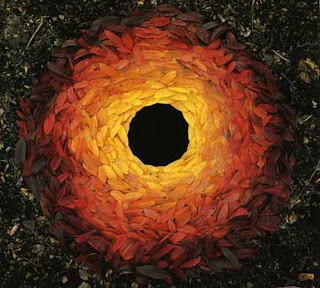Keywords: environmental art, land art
Source: wikipedia
Andy Goldsworthy is a British sculptor, photographer and environmentalist living in Scotland who produces site-specific sculpture and land art situated in natural and urban settings. His art involves the use of natural and found objects, to create both temporary and permanent sculptures which draw out the character of their environment.
Artistic style
The materials used in Andy Goldsworthy's art often include brightly-coloured flowers, icicles, leaves, mud, pinecones, snow, stone, twigs, and thorns. He has been quoted as saying, "I think it's incredibly brave to be working with flowers and leaves and petals. But I have to: I can't edit the materials I work with. My remit is to work with nature as a whole."Goldsworthy is generally considered the founder of modern rock balancing. For his ephemeral works, Goldsworthy often uses only his bare hands, teeth, and found tools to prepare and arrange the materials; however, for his permanent sculptures like "Roof", "Stone River" and "Three Cairns", "Moonlit Path" (Petworth, West Sussex, 2002) and "Chalk Stones" in the South Downs, near West Dean, West Sussex he has also employed the use of machine tools. To create "Roof", Goldsworthy worked with his assistant and five British dry-stone wallers, who were used to make sure the structure could withstand time and nature.
Photography plays a crucial role in his art due to its often ephemeral and transient state. According to Goldsworthy, "Each work grows, stays, decays – integral parts of a cycle which the photograph shows at its heights, marking the moment when the work is most alive. There is an intensity about a work at its peak that I hope is expressed in the image. Process and decay are implicit."
Goldsworthy produced a commissioned work for the entry courtyard of San Francisco's De Young Museum called "Drawn Stone", which echoes San Francisco's frequent earthquakes and their effects. His installation included a giant crack in the pavement that broke off into smaller cracks, and broken limestone, which could be used for benches. The smaller cracks were made with a hammer adding unpredictability to the work as he created it.
Quotations
* "I find some of my new works disturbing, just as I find nature as a whole disturbing. The landscape is often perceived as pastoral, pretty, beautiful – something to be enjoyed as a backdrop to your weekend before going back to the nitty-gritty of urban life. But anybody who works the land knows it's not like that. Nature can be harsh – difficult and brutal, as well as beautiful. You couldn't walk five minutes from here without coming across something that is dead or decaying."
* "One of the beauties of art is that it reflects an artist's entire life. What I've learned over the past 30 years is really beginning to inform what I make. I hope that process continues until I die."
Biography
Born 26 July 1956 (1956-07-26) (age 53)
Cheshire, England
Nationality British
Field Sculpture; photography
Training Bradford College of Art (1974–1975); Preston Polytechnic (now University of Central Lancashire) (1975–1978)
Movement Environmental art and land art
Influenced by Constantin Brancusi; Richard Long; Robert Smithson; Joseph Beuys; Ben Nicholson; Paul Nash; David Nash
Awards Scottish Arts Council Award (1987); honorary degree from the University of Bradford (1993); OBE (2000)
 Spire(2008), Park Presidio San Francisco, CA
Spire(2008), Park Presidio San Francisco, CA Storm King Wall (2000), Storm King Art Center Mountainville, Cornwall, New York, USA
Storm King Wall (2000), Storm King Art Center Mountainville, Cornwall, New York, USA Autumn Work(2002), Storm King Park, USA
Autumn Work(2002), Storm King Park, USAA clip from River and Tides, a documentary on Andy Goldsworthy and his art:
The documentary, “River and Tides” vividly illustrated how Andy works with nature. Given the transient nature of his work, I think a film is the best way to document the process of his work. Andy’s work is not a stagnant art, it is a fluid flow, a process of time which every minutes of time counts into part of the art work. This feature of Andy’s work reminds me the Spiral Jetty by another earth scultpor Robert Smithson. Their artwork is an eulogy of time and nature, the universe. You don’t stand in front of an art work to appreciate it, rather, you walk into it, become part of it, you are the observer as well as the creator.
When watching the film, the biggest thing I was Andy’s internal affinity to nature. He said: “if I don’t work for a time, I do feel rootless. I don’t know myself. If I don’t work for two or three weeks, then if I go to give a lecture, I feel as if I’m talking about someone else’s work. “ Andy is just like a little boy playing with nature alone, nature never failed to fascinates him, he never get bored of it. His artwork consolidates and amplified the subtle beauty of nature. Andy’s work makes you see something that’s always there but you are blind to it. He does not use any tools in the process of building his work. He did it all by hand.
The beauty of his work is it won’t stay long. In the film, a little nest built by short wood bricks in the water was gradually washed away by torrents. Andy just standing there, staring at it dissolving. “as if it takes off to another world, I didn’t feel at all, destruction.” This process of transiency makes me think of architecture, which is, definitely the antithesis of environmental artist’s work. Architectures protrude, impose and incrust on natural. What form should it take to compensate the changes it have made? Should it be organic externally or internally?
What is the meaning of Andy’s artwork? I think it is like all other art work, it is there to evoke a thought, a thousands of similar thought to consonant.

No comments:
Post a Comment